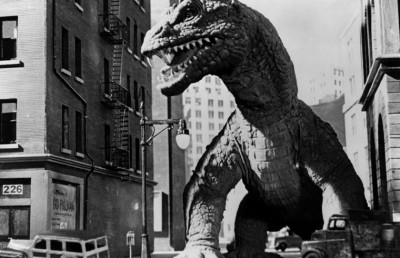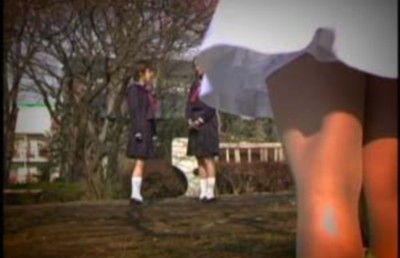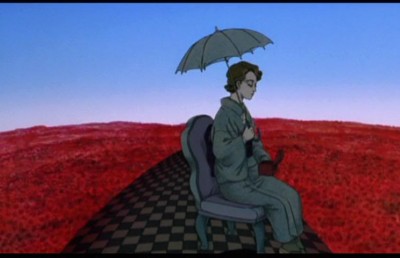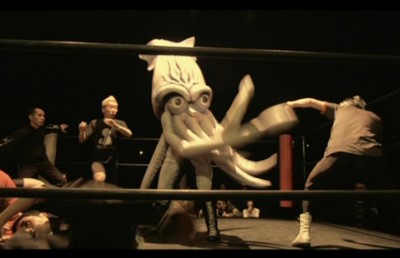Firecracker: An Interview with Steve Balderson
True Indie Spirit
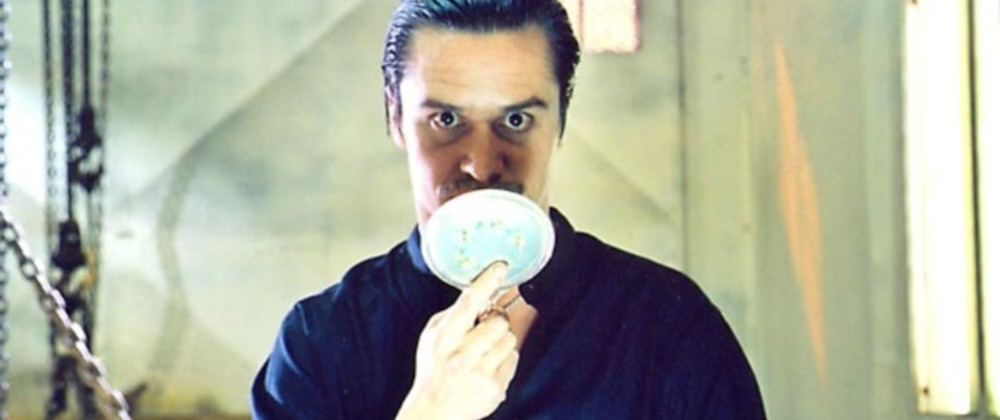
One of the more emotionally involving and formally inventive films at FanTasia this year was a low budget, independently produced US film entitled Firecracker. The film is based on a lurid murder from the 1950s that occurred in director/screenwriter Steve Balderson’s hometown of Wamego, Kansas. Balderson uses the murder to dissect a dysfunctional rural family comprised of a religious zealot matriarch (sublimely played by Karen Black), her two sons, the younger, introverted ‘outcast’ Jimmy (Jak Kendall) and sociopathic older brother Frank, and their comatose father. Balderson contrasts these oppressive, black & white ‘family’ scenes with garishly colored scenes that take place at a visiting carnival show. The two ‘worlds’ seem a gulf apart on the surface, but are symbiotically drawn together by paralleling characters (Karen Black and Michael Patton play dual roles that feature separately in the two locations, Sandra/Eleanor and Frank/David), situations, and emotions.
Anyone interested in the nuts n’ bolts of true independent filmmaking will be enthralled by Balderson’s engrossing ‘making of’ documentary, Wamego: Making Movies Anywhere, which makes a fascinating companion piece to the film. Copies of the documentary can be purchased or acquired from the film’s official website, in the “Bonus” section. (A two-minute excerpt of the documentary can also be downloaded from the website.)
Offscreen is pleased to present this in-depth interview on Firecracker with its director-writer Steve Balderson. Be forewarned that the interview contains many SPOILERS. All photos have been taken from the film’s official website or still captures from the documentary Wamego: Making Movies Anywhere.
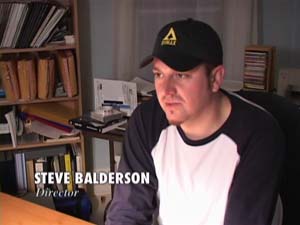
_____________________________________________
Offscreen: The real story on which the film is based is interesting, but not exactly something extraordinary in view of the America’s violent history. What was it that attracted you to the ‘story’?
Steve Balderson: The story happened a couple blocks from where I grew up. My dad was very young, but his older sister was seventeen at the time. She and her friend Connie were actually there on the alley when they dug up the body! You can hear my telephone conversation with Connie, on my site, under “session 3”. I’ve always been obsessed with the story. I imagine a similar story that happened elsewhere probably wouldn’t have appealed to me as much as this one.
Offscreen: Just a technical question: Was the opening shot on the road done with a steadicam?
Steve Balderson: Actually, it was done on the bed of my truck. Kirk, our sound guy, drove the truck in reverse down the center of the street for those shots. It was great because most of the crew was back at the sound stage setting up for the next scene. I love working small and quickly. Shooting that scene was a highlight.
Offscreen: I like the sly reflexive gesture you had near the end of that opening where you see a young guy filming the event with a 16mm hand-held Bolex camera (it looked like a Bolex). Was that like your equivalent to Hitchcock’s cameo appearances?
Steve Balderson: Thank you. That is my brother Scott holding the camera. It’s my late grandfather’s camera. In real life, my grandfather was there, taking pictures—he always took pictures. When it came time to re-create that scene, I had my brother play our grandfather. My cameo comes later, in the poster running for Mayor. In Pep Squad, my first film, my cameo came when my picture appeared on a milk carton.
Offscreen: How much did you embellish the actual ‘facts’ of the case? For example, you stress the sexuality, largely as an expression of power and dominance. But was David’s homosexual rape of Jimmy part of the historical event or did you add it? And if so, why did you feel the need to add it?
Steve Balderson: It was true. Strangely enough, most of the atrocious and wicked things in the film were actually part of the real story. The things I added for cinematic purposes are fairly tame and only there to keep the film under a decent running time. I’d say 90% of the film is based in absolute fact. Leaving the remaining 10% for cinematic visuals.
Offscreen: This latter question is intended with another question in mind. I don’t really think the film is about fratricide or the particular murder, but more about being an outsider, a social ‘freak.’ We see this in Jimmy (Jak Kendall), who is a sensitive, artistic person alienated by the small town mentality. I was wondering whether this position that Jimmy finds himself in can be seen as a metaphor of sorts for growing up gay in a conservative, small-town environment. First of all there is David’s fear of Jimmy’s ‘feminine’ side, and his drive to make Jimmy a ‘man.’ And of course it is quite ironic that David found it necessary to sodomize him to make him a ‘man.’ There is also another side to the rape. The one place where male rape occurs regularly is in prison. The fact that David rapes Jimmy fits in with the idea that Jimmy is in fact a ‘prisoner’ in his own home. Hence the rape has that symbolic side to it, as well as the more direct sexual side. This rather long winded explication is more of a comment than a direct question, but I was curious to hear your own feelings on this interpretation.
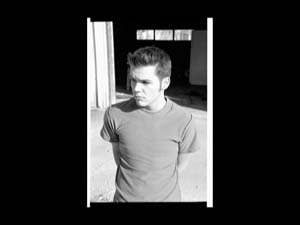
Steve Balderson: Exactly. You phrased it perfectly. Jimmy is to the town of Wamego what the circus freak is to the sideshow. Their stories are parallel. One of the ways you can see this is by looking at the color rules of the film. I assigned a color to each of the characters and removed that color from the entire film unless it had direct association with that character. Sandra was red, Eleanor green (opposing colors) and Jimmy, who was also opposite Sandra, and yet related to Eleanor, is blue (literally). The only other character allowed to wear, or to be, blue, was The Enigma.
They are, simply—outcasts. They don’t belong. And because they’re different, no one else wants them to fit in. They threaten the power structure because it’s clear they have an independent thought. They are acting alone. Whether one is an artist, a free-thinker, not bound by societal expectations on religion, sexuality, politics—the bottom line comes down to the culture. I don’t see a single place in our world which isn’t bigoted or judgmental. I see the same behaviour in the bigger cities that I see in the small towns. The only difference is the population.
Specifically, as it relates to sexuality, I’ve known quite a few men who define themselves as heterosexual yet have had multiple sexual experiences with another man. In addition to physical violence and using force to establish his control, David uses sexuality as a tool. He does it frequently, as you’ll notice in subtle scenes throughout. But I’d say he is not interested in homosexual activity for the sake of homosexuality. With him, it’s about the power.
Jimmy, on the other hand, probably has no sexuality. One who grows up with experience of sexual activity being what his was does not look for it. Jimmy learned there was nothing pleasurable about it. So when he meets someone new, like Sandra, he isn’t thinking of sex. He’s actually thinking about the real things in life. Naïve, yes… But genuine.
Some people are convinced the world of the carnival is Jimmy’s fantasy. That in order for him to confront his abuse and deal with it, he had to invent a situation that mirrored his own. I’m never going to say whether or not that is the reason I executed the film the way I did. But, if one was arguing that now, it would make sense.
Offscreen: There is also irony in the scene where Sandra calls Jimmy from the phone booth when she momentarily escapes and tells him, “I’m free Jimmy.” Green lighting is often used in film to suggest death, and the lighting on her during the phone booth scene is green. Hence we could read this as a foreshadowing of her death. Since you were so careful with the use of color, I wonder if this green lighting was intended as such?
Steve Balderson: I’ll never tell. However, your perception of that scene makes sense. In addition to foreshadowing death, if one is going to argue that Sandra represents all that Jimmy wants his mother to be, and Eleanor is green (the only character allowed to wear green), it could be a way for Jimmy to say “goodbye” to Eleanor. The timing of that scene is crucial to supporting that theory. From that moment on, we never again see Eleanor.
But, again… there are many ways to see it.
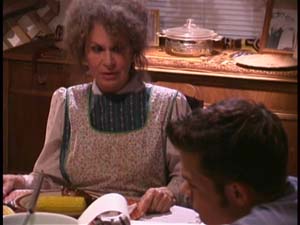
Offscreen: There was a point made by an audience member after the screening at Fantasia that the community represented in the film is very matriarchal. You can see this with the sheriff character Ed (Susan Traylor), who is a woman, the two characters played by Karen Black, even one of the mechanics is a woman; and of course the character of Pearl, the ‘mother earth’ figure or ‘conscience’ of the piece. And this is counter pointed by the useless, comatose father figure. And from what I gathered on the clips shown in the documentary Wamego, your earlier film Pep Squad also has strong female characters. Was this a conscious decision, or something that naturally arose as a result of the writing process?
Steve Balderson: In my world, I am surrounded by powerful female leaders. My mother, sister, aunts, cousins – all of them are strong women. Growing up, powerful women were in charge of many aspects of the world around me: families, local businesses, even the city offices. The local chamber of commerce director was a woman named Rosemary Crilly. She was more powerful than anyone in town. If you wanted something done, you’d go to her. I never really knew females who were not leaders. I never really knew that some women prefer to stay at home and raise babies. Then, as I got older, I realized how different the rest of the world actually is. I think it’s probably natural these themes come out in my writing—but I am conscious of them as well.
Offscreen: Returning to the issue of power, I like the way you usurp conventional modes of power, like Frank’s (and David’s) strong-armed tactics, with subtle cinematic techniques. For example, in the scene where Frank ties up Sandra and puts her on display, she subverts his dominance by singing her song; and the way she is lit, bathed in white light, makes it her moment, rather than Frank’s. It almost seems as if she has escaped or has attained freedom. The singing is like an act of defiance. The same thing happens when she is captured and beat up at the end. The slow motion camera remains on her face and her facial gestures and movements again give an impression of an inner realm that she has entered. She seems to be experiencing some sort of euphoria rather than pain. I guess you can say that this goes back to the earlier point about the film positioning itself on the side of matriarchy. Did you see the film as also being about usurping male violence and male power?
Steve Balderson: Exactly. For Sandra, singing is her only escape. Until she’s running from the crowd and realizes that her greatest escape would be to die. So she spins around and welcomes them with open arms. It’s as if she had the last word—like she won the fight. And throughout, as you noticed, I love the strong female. Even in a situation where the female could be viewed as a victim, there is always something that keeps the female ahead of the male.
Offscreen: Although the film is about an event that occurred in the 1950s, your film does not situate itself in any one time frame. One of the ways this is achieved is with the non-linear narrative structure, which makes the film feel ‘out of time.’ We see this directly in the flashbacks and the way they make links between characters, like the way Jimmy and his mother are given a ‘shared’ history of physical and sexual abuse through the scenes of Jimmy being raped by David and Eleanor being whipped by a man, who we assume is her husband. Can you talk about how important this non-temporal specificity was to what you wanted to achieve with the film?
Steve Balderson: The scene with Eleanor being whipped is actually David. It’s quick, but you can see him, and she actually says, “David, don’t do that!”
I chose to show the story this way because it’s thematically timeless. The spirit of its energy does not date. The world of Firecracker transcends time. It is an entity itself and should not be placed in a definitive, superficial place in existence. As long as people continue to live in denial and repression, we will always have themes shown in this film.
Also, small town America is, in a sense, lost in time. Many people from cities don’t realize that there are still portions of America that look out of the Fifties and Sixties. There are still old cars driving around town. Women still wear bouffant hairstyles. Clothing, often found in second hand stores, is period costuming!
Playing with the dichotomy between Kansas and the Carnival is another thing I like about having timelessness. In the world of Wamego, things are photographed as if they were shot in the Fifties or Sixties, whereas the carnival, in addition to being photographed in 21st Century color, has a very modern décor. This shows us there is a fear of change in the small town, and a welcoming of change in the nomadic world of the carnival. I also have Ed (Susan Traylor) say, in the diner, “Your clock is out again.” Time itself is an interesting concept to me. To say it doesn’t exist might be foolish, but I like the idea, even in real life.
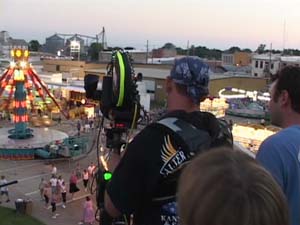
Offscreen: It is obvious for anyone who looks close enough that you use color and black & white quite thematically. (Also, given the location of Wamego, Kansas, the use of color and black & white could very well be a nod to A Wizard of Oz.) For example, the first time we see color is when Jimmy visits the carnival for the first time. We also see the carnival for the first time through Jimmy’s eyes, and what he sees in terms of color is a highly saturated, unreal world that appears magical; a fantasy world that he would like to escape into. First of all, a technical question: how did you achieve the color saturation? Secondly, and as much a comment as a question, I find the use of the colourful carnival very ironic, in that it is first presented as this magical-fantastic escape environment, but then when we discover what goes on there, with the brutality at the hands of Frank, the ‘fantasy’ world is just as bad, and harbours as much anger and hatred as the ‘reality’ black & white. We see this also during the rape scenes with cuts to color flashbacks, so color may begin as representing something magical, but the horrors of reality slowly seep into the color world too. Would this be a fair assessment of the function of the color and B/W scheme?
Steve Balderson: The color saturation was achieved by working with a gifted colorist—Dan Holmgren of Imagemakers. Dan and Walter, the guy at Fotokem, made the color what it is. They worked tirelessly for more than a month. My cinematographer, Jonah, was not responsible for the color at all. In fact, getting Jonah to actually push the color when we were filming was like asking for a kidney. He just wouldn’t do it. And when the dailies came back they looked repulsive. But, I realized that I would have full control in post production. So I let Jonah photograph what he wanted knowing full well I would be changing it later on. Thank the heavens for modern technology! When it was time for us to do the color work during post production, we did it without Jonah all together. It’s a little unnerving that when we recently won Best Cinematography Jonah’s name was on the trophy. But, such is life. Jonah knows he didn’t do it. So he’ll have to live with it. I just feel bad for Dan and Walter since they did all the work.
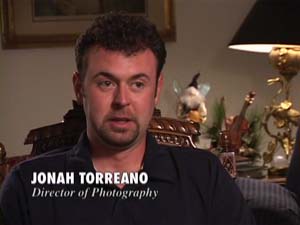
Your assessment of the Color and B&W role is great. I use color as a character, in a way. The “fantasy” world is definitely as terrible as the “reality” world. Sometimes people think if they move somewhere else, they’ll have it all together. Or, where they currently are isn’t as better as ‘over there.’ But what people discover is that ‘over there’ is exactly like ‘here.’ Like I mentioned earlier—the only difference between Wamego, Kansas, and a major city like New York or Los Angeles, is the population. We have exactly the same things. We may not have Broadway, but we have a theatre. Dorothy learned this message in the Wizard of Oz, and Jimmy finally realised that in Firecracker. By the end of the film, the worlds switch places. As Sandra dies, her world turns B&W. The moment Jimmy finally confronts Eleanor, his world turns to color.
Offscreen: Another element which made me feel this way toward the carnival scene and in particular our introduction to it, is how the camera style in this opening, flowing and almost dreamlike (with a steadicam I would imagine), echoes the camera movement of the opening shot of the film (the B/W shots moving forward along the road, ending up at the shed). In the opening scene the movement eventually leads us to a ‘terrible discovery’: the corpse in the shed. Hence when we get the same camera movement style in the scene where Jimmy first visits the carnival, somewhere in our minds we subconsciously if not consciously, relate it to the opening scene and intuit that something is amiss. I know you were very specific and controlled with most everything in the film, but was this also a conscious thematic use of camera movement, or am I just reading into it?
Steve Balderson: Yes, you’re right on target. And, indeed, Jimmy’s entrance to the carnival was shot with a steadicam. I wanted a certain hypnotic feeling for both scenes. And the way the image is very centered in perspective was crucial (to keep the visual focus in the center of each image, as opposed to far-right or far-left, the wideness of the cinemascope ratio could better encompass the viewer’s periphery).
Another point in the film I use the same hypnotically slow theme, with center focus, is the shot I call the “Pieta” with Jimmy carrying David’s body down the hall. The only difference, here, is we’re in reverse. So it’s the ‘leaving of terror’ or the opposite of the carnival and opening scenes.
Offscreen: Yes I noticed that shot referencing “La Pieta.” Why this religious reference at that point in the film with a character, David, who was anything but “Christ-like”?
Steve Balderson: Right—David is everything but “Christ-like.” I used the composition because of the root of the word. Latin “pietas” is to properly honour and respect parents. “Piety” is 1) The state or quality of being pious, especially: a) Religious devotion and reverence to God; b) Devotion and reverence to parents and family: filial piety. [Middle English piete, mercy, pity, from Old French, from Latin pietas, dutiful conduct, from pius, dutiful.]
Chilling—Especially if you listen carefully to what Eleanor is really telling Jimmy in the scene prior.
Thank you for picking up on that shot. It’s one of my favourites. We actually spent a long time trying to get Patton’s body to hang correctly. Because Jak Kendall (Jimmy) is much smaller than Mike Patton, and Mike weighed more than Jak could normally lift, it was very difficult to get it perfect. But we did it.
Offscreen: Watching the documentary on the making of Firecracker, Wamego: A Documentary, Making Movies Anywhere, we learn that at the script level you had several big name actors interested in the key roles of Sandra/Eleanor and David/Frank. Your first choice was always Karen Black but she refused the part at first. The two other people who were considered for that role were Deborah Harry and then Sissy Spacek. And for the male role, James Russo and then Dennis Hopper. It was quite courageous of you to let go of the big name actors and stick to your initial conception of having the same actor play dual roles. What was it about Karen Black that made her your ideal choice?
Steve Balderson: Karen Black is a genius. I understand that Karen isn’t as “famous” today as, say, Sissy Spacek, but I believe she’s hosted Saturday Night Live more than once! There comes a time in life when an artist has to pick quality of craftsmanship over fame. Sometimes you can’t have both. If I had to make a choice, I’d rather stick with craftsmanship. That isn’t to say Sissy Spacek isn’t talented—because she is—it’s just that with Karen, there was never a second of apprehension. She’s the most excellent. When it comes down to the character and the ‘being’ that character—Karen is completely there.
Karen first turned me down because she said she didn’t know if she could live through it. She compared it to the feeling of imprisonment she felt during the making of Altman’s Come Back to the Five and Dime, Jimmy Dean, Jimmy Dean. But when I met Karen face to face, she said she would do it. I remember her saying something about how different I was. I mean, that she read the script and expected me to be a certain way, look a certain way, but that when we met, and got to know one another, that I was well… more ‘normal’ than she expected. Or something like that. Perhaps she felt we were good people and would take care of her. So if she did go deep into these women, there would be a safe zone to do it in.
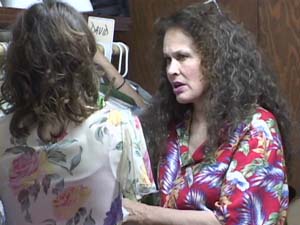
When Dennis Hopper came on board as Frank, he offered to produce the film, and bring ten million dollars to the table. Obviously, I was hypnotized. So I cast him right away. But a few months later, his deal fell through, thus meaning Dennis wouldn’t be bringing money to the table, so we had to find the funding on our own. I thought, well, we have someone famous in the movie, so we can easily find the funding. I was mistaken. A year passed and we still couldn’t find financing. It was quite a shock to learn that having a celebrity in a film doesn’t guarantee it will be made! And if I had to do all the work, I sure as hell wasn’t going to work hard to make a film that did not meet my original conception!
Hopper was too old to play David. He couldn’t play both parts. So if I kept him on, I couldn’t make the film the way I’d originally planned. And, since there was no glorious “Hollywood” fame-and-fortune, there was no reason to keep him. I had to let him go. I wrote letters to the cast and explained to them I had to be true to myself. That Karen and Mike would play dual roles and that I had to let all of them go. And that was it. Then, seemingly overnight, we found the financing to make the film. One more notch to the rule: Everything Happens For A Reason.
Offscreen: If there was any justice in the film world Karen Black would win an Oscar Best Actress nomination for her dual performance. I think she was just great, in both roles. Her turn as Eleanor was especially great, and reminded me of the grand tradition of the Hollywood Southern Gothic; performances such as those by Bette Davis in Whatever Happened to Baby Jane? and Hush, Hush Sweet Charlotte, Geraldine Page, Shelley Winters, etc. Was Karen Black directly influenced by these earlier performances? Or was it a question of your own awareness of these performances? I wondered about this also because Karen Black acted together with Bette Davis in a horror film entitled Burnt Offering (1976)?
Steve Balderson: I agree. Though, as I’ve gotten older and more experienced, I’ve learned that many things associated with the industry aren’t fair. In fact, they aren’t as decent as they appear at all! It really is about who you know and how political you can be. The IFP, for instance, (the Independent Feature Project) never return my calls (I call about twice a month to the IFP in Chicago and the one in LA) and have never acknowledged us. Why, I wonder? I sent them a DVD of Wamego: Making Movies Anywhere in hopes they would see you can’t get more independent! But, alas… Nothing. So I’m convinced that as long as I’m not sipping martinis at the Chateau Marmont, or going to the annual BBQ, I am not part of the clique. And, if I can’t get the attention of the people who are supposedly supporting independent films, I’m not holding my breath we’ll gain attention from the Academy.
I also think Karen might have many enemies. I know nothing for certain – it’s just a hunch. So while her work is worthy of an Oscar from a craftsmanship standpoint, I understand that it’s just wishful thinking.
I don’t think Karen is influenced one way or the other about other actors in other roles. I mean to say when it’s time for her to do the job, she looks inward—not outward—for the answers. She listens to her instincts and her knowledge of how people really behave. And instead of pretending, she becomes them. Like a light switch on the wall, she can turn on and off her characters with effortlessness. Clearly she spends a lot of time researching and getting to know aspects about the women she portrays.
Offscreen: Mike Patton was also very convincing in his dual performances. I was wondering how much attention went into his dress and makeup as Frank, because I could swear that with his goatee and his black/red coat I saw little horns jutting out of his forehead!
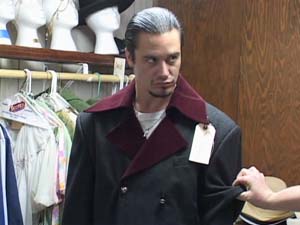
Steve Balderson: HA! Actually, very little went into Patton’s “design” as Frank. Frank is, visually, Patton. David, on the other hand, is totally different. Settling on a “design” for David was much more difficult. But in the end make up artist Linda Sammut and I settled on the one most appropriate for the part.
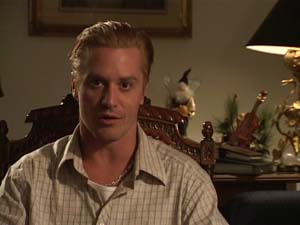
I think more people would recognize how brilliant Mike’s portrayals are if his characters would have gone back and forth for two hours. Karen’s characters go back and forth throughout the film. We really get to see her as two totally different people. But because Frank comes in right around the time David is killed, there is no back and forth. So people don’t really comprehend how brilliant he is in both roles.
Offscreen: The French song that Sandra sings is, I believe, a Quebec song. If so, how did that selection come across?
Steve Balderson: Out of all the songs we searched through—none of which were in the public domain—Tino Rossi’s “J’attendrai” was Karen’s favourite choice. She sang it to me one day on my voice mail and I got chills. The words of the song haunted me. Originally, when I was much younger (I wrote Firecracker when I was 22 and completed it when I turned 30), I’d written the song to be Roberta Flack’s rendition of “Will You Still Love Me Tomorrow?” As I aged and became aware of life, I felt so fortunate for having picked the song we did. The Roberta Flack song would’ve come across really trite. I don’t mind saying that—at 22, I hadn’t the foggiest idea of what it meant to be an adult. I didn’t know truth.
Actually, the version we hear as Jimmy enters the side-show for the first time is the actual recording from my answering machine when Karen first sang to me.
Offscreen: Pearl’s admonishment of the community near the end is reminiscent of criticism against US during the Vietnam era. It made me remember what Wes Craven said about Last House on the Left, a film in which a normal, middle class American family is driven by vengeance to commit violent acts of murder. Craven said that the film was an outgrowth, or a reaction to, what was going on in America at the time; the way most Americans were not acknowledging their own complicity in the violence occurring in America (during the Civil Rights movement) and in Vietnam. The way the violence was being swept under the proverbial rug. Can one say the same about Firecracker in today’s political landscape?
Steve Balderson: Yes. She’s speaking about our culture’s failure to confront what we always want to hide. Instead of coming to terms with the truth—Eleanor would rather look up to the heavens, Jimmy would rather look at the floor, Ed would rather eat chocolate pie.
I say none of us wants to confront our demons and admit our fears. That’s why Pearl stares straight at the audience. To remind them that the movie they are watching is a big mirror, showing them parts of themselves they’d rather deny. When I hear negative reaction to the film, it’s always coming from people who can’t look at themselves in a mirror. Human behaviour is fascinating to me.
Offscreen: Can you talk a little about your influences. I know some people after the screening were comparing your film to David Lynch, in particular Twin Peaks, with the scenes at the diner. I would agree somewhat, but also see a big difference: Lynch is not interested in social issues or making commentary on the human condition, whereas your film does. How do you feel about the comparisons to Lynch?
Steve Balderson: On one hand, I’m tired of them. In the beginning it was very flattering. On the other hand, I do recognize that people, in general, have a need to define something in order to understand what it is. Because Lynch shows us images we aren’t used to seeing, if another artist shows them images they aren’t used to seeing they make their definition fit. Cronenberg is making movies with equally original and sometimes bizarre imagery. So are the Coen brothers. I imagine that after I’ve made another film or two the Lynch references will stop. Firecracker is, after all, the second thing I’ve ever created on celluloid.
The diner in the film is where I used to eat lunch every day. In Belvue, Kansas. We actually became obsessed with their chocolate desserts. And there was an ongoing debate about which was better – the chocolate cake or the chocolate pie. My brother insists the cake was better. Others insist the pie is better. That was my motivation for putting it into the movie. Not Twin Peaks. It’s also a way for me to show that Ed and Harry are more concerned with their daily routine than they are in actually taking action against any wrongdoers.
Offscreen: Another more direct and worthwhile comparison is to Tod Browning’s Freaks. Like Browning’s film there is a nice sense of solidarity among the carnival performers; and the finale where Frank’s henchmen avenge Frank’s death by chasing and beating Sandra to death is an inversion of the finale of Freaks, where the performers avenge one of their own, Hans, by chasing the malicious human character, Cleopatra, and turning her into a ‘freakish’ bird woman. How influential was Freaks to you? Where there any other films that influenced you?
Steve Balderson: I love Freaks. I did watch it when it was time to build the gypsy wagons, because I couldn’t find anything about what they looked like! There were some places online, and Professor Marvel’s wagon in The Wizard of Oz, but nothing else.
To say the imagery in Firecracker wasn’t influenced by something I’ve seen would be asinine of me to believe. I’ve lived my life and what I’ve seen and experienced has ways of morphing in my psyche and coming out in what I create. But when it came time for me to research the true story, sketch the storyboards, and design the spaces—I took every step possible to not be influenced by anything outside my head. For several years I didn’t watch anything. No movies. No television. Only music. I listened to Chopin’s Nocturnes (what Jimmy plays on the piano) and several tragic operas.
During the process of making Firecracker I made one exception with a film: Eyes Wide Shut. When I saw it in the theatre there were only a few people there. It was an exquisite experience. It felt very private and perfect. When the credits rolled I said to myself, “I never have to go to the cinema again.” And I haven’t. There’s no need. It can’t top that astounding experience.
Offscreen: Another question on a specific shot. I read your section “Mirror Image” on the film’s website so I got some of the background necessary to understanding the Pearl character (played by Steve’s sister Brooke Balderson), her “bottle tree,” etc. In the reading it states that negative spirits are attracted to the tree and henceforth contained in the bottles. Near the end of the film when Pearl leads them to where the body is buried we see Pearl dig up the earth to expose David’s hand and then whisk at the air, as if to capture something. She then says, and I paraphrase, ‘the tree is now complete.” Is this moment supposed to mean that Pearl has captured David’s soul and trapped it into a bottle on the tree?
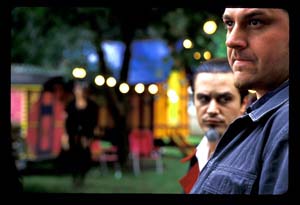
Steve Balderson: Yes. In the film, Pearl takes David’s spirit from the site and deposits it near her bottle tree when she returns to her field. When she lets go of the spirit, she says nothing. I think it’s fantastic you heard something! To go back to one of your earlier questions, I must say that the only major outside influence I had while creating Firecracker came when I first learned about bottle trees and the dikenga. I was most influenced by the art associated with all aspects of the Yoruban religion. Until that moment, I hadn’t seen anything like it.



